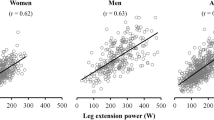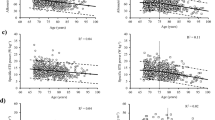Abstract
Power has been demonstrated to be an early and potent marker of frailty. The measurements currently available are tied to locality. Usually, measurements include single joint movements or movements of only the legs and the resistance is not adjusted for body weight. In this study, a portable method to measure power in the sit-to-stand transfer was developed and tested. Mean power was calculated from the vertical ground reaction force of body weight, the difference between height in a sitting and in an upright position and the time taken to stand up. The results of this power measurement were compared with an isokinetic force measurement, the "Nottingham power rig", and measurement of physical performance in a five-repetition chair rise (five-chair rise). A convenience sample of 33 healthy elderly subjects [mean (SD) age: 67.8 (6.7) years; 17 men, 16 women] was included. Measurement of power during the sit-to-stand transfer showed good correlation to isokinetic force measurement (r=0.68) and to the "Nottingham power rig" (r=0.6). Correlation to five-chair rise was poor (r=−0.08). In conclusion, the study shows that the method presented is able to measure power during performance of a daily task. The poor correlation between the introduced measurement and the five-chair rise suggests that it might be able to detect decline in muscle function earlier by the introduced measurement than by measurement of the functional status. As it is inexpensive and portable, its use in clinical practice and research contexts, including home-bound individuals, is feasible.

Similar content being viewed by others
References
Bassey E, Short A (1990) A new method for measuring power output in a single leg extension: feasibility, reliability and validity. Eur J Appl Physiol 60:385–390
Bassey E, Fiatarone M, O'Neill E, Kelly M, Evans W, Lipsitz L (1992) Leg extensor power and functional performance in very old men and women. Clin Sci (Colch) 82:321–327
Chandler J, Duncan P, Studenski S (1997) Choosing the best strength measure in frail older persons: Importance of task specifity. Muscle Nerve [Suppl] 5:47–51
Davies CT, White MJ, Young K (1983) Electrically evoked and voluntary maximal isometric tension in relation to dynamic muscle performance in elderly male subjects. Eur J Appl Physiol Occup Physiol 51:37–43
Evans W (2000) Exercise strategies should be designed to increase muscle power (editorial comment). J Gerontol A Biol Sci Med Sci 55: M309–310
Fleiss J (1986) The design and analysis of clinical experiments. Wiley, New York
Fleming B, Wilson D, Pendergast D (1991) A portable, easily performed muscle power test and its association with falls by elderly persons. Arch Phys Med Rehabil 72:886–889
Guralnik J, Simonsick E, Ferrucci L, et al (1994) A short physical performance battery assessing lower extremity function: association with self-reported disability and prediction of mortality and nursing home admission. J Gerontol 49:M85–94
Harridge S, Young A (2000) Strength and power. In: Evans J, Williams T, Beattie B, et al (eds) Oxford textbook of geriatric medicine, vol 2. Langton, Oxford
Hirschfeld H, Thorsteinsdottir M, Olsson E (1999) Coordinated ground forces exerted by buttocks and feet are adequately programmed for weight transfer during sit-to-stand. J Neurophysiol 82:3021–3029
Jozsi A, Campbell W, Joseph L, Davey S, Evans W (1999) Changes in power with resistance training in older and younger men and women. J Gerontol A Biol Sci Med Sci 54:M591–596
Kostka T, Rahmani A, Berthouze SE, Lacour JR, Bonnefoy M (2000) Quadriceps muscle function in relation to habitual physical activity and VO2max in men and women aged more than 65 years. J Gerontol A Biol Sci Med Sci 55:B481–488
Kralj A, Jaeger R, Munih M (1990) Analysis of standing up and sitting down in humans: definitions and normative data presentation. J Biomech 23:1123–1138
Lingard EA, Katz JN, Wright RJ, Wright EA, Sledge CB (2001) Validity and responsiveness of the Knee Society Clinical Rating System in comparison with the SF-36 and WOMAC. J Bone Joint Surg [Am] 83:1856–1864
Manchester D, Woollacott M, Zederbauer-Hylton N, Marin O (1989) Visual, vestibular and somatosensory contributions to balance control in the older adult. J Gerontol A Biol Sci Med Sci 44:M118–127
Martin J, Farrar R, Wagner B, Spirduso W (2000) Maximal power across the lifespan (see comments). J Gerontol A Biol Sci Med Sci 55:M311–316
Pearson SJ, Harridge SDR, Grieve DW, Young A, Woledge RC (2001) A variable inertial system for measuring the contractile properties of human muscle. Med Sci Sports Exerc 33:2072–2076
Rahmani A, Belli A, Kostka T, Dalleau G, Bonnefoy M, Lacour JR (1999) Evaluation of knee extensor muscles under non-isokinetic conditions in elderly subjects. J Appl Biomech 15:337–344
Roebroek M, Doorenbosch C, Harlaar J, Jacobs R, Lankhorst G (1994) Biomechanics and muscular activity during sit-to-stand transfer. Clin Biomech 9:235–244
Schenkman M, Hughes M, Samsa G, Studenski S (1996) The relative importance of strength and balance in chair rise by functionally impaired older individuals. J Am Geriatr Soc 44:1441–1446
Skelton D, Young A, Greig C, Malbut K (1995) Effects of resistance training on strength, power, and selected functional abilities of women aged 75 and older. J Am Geriatr Soc 43:1081–1087
Acknowledgements
We acknowledge the help of Wiebren Zijlstra, University of Groningen, who discussed our results, and Barbara Eichner, Bethesda Geriatric Hospital Ulm, who was responsible for data management. The study was supported by the Bethesda Geriatric Hospital Ulm, Academic Centre at the University of Ulm and Martin Conzelmann, Felix Platter Spital in Basel. This study complies with the current laws of Germany.
Author information
Authors and Affiliations
Corresponding author
Rights and permissions
About this article
Cite this article
Lindemann, U., Claus, H., Stuber, M. et al. Measuring power during the sit-to-stand transfer. Eur J Appl Physiol 89, 466–470 (2003). https://doi.org/10.1007/s00421-003-0837-z
Accepted:
Published:
Issue Date:
DOI: https://doi.org/10.1007/s00421-003-0837-z




